If you’re a fan of Chinese fried noodles, you must try today’s recipe for Singapore Mei Fun, a hearty all-in-one dish full of goodness and great flavours. Many cooking tips and substitute ideas are provided throughout the post.
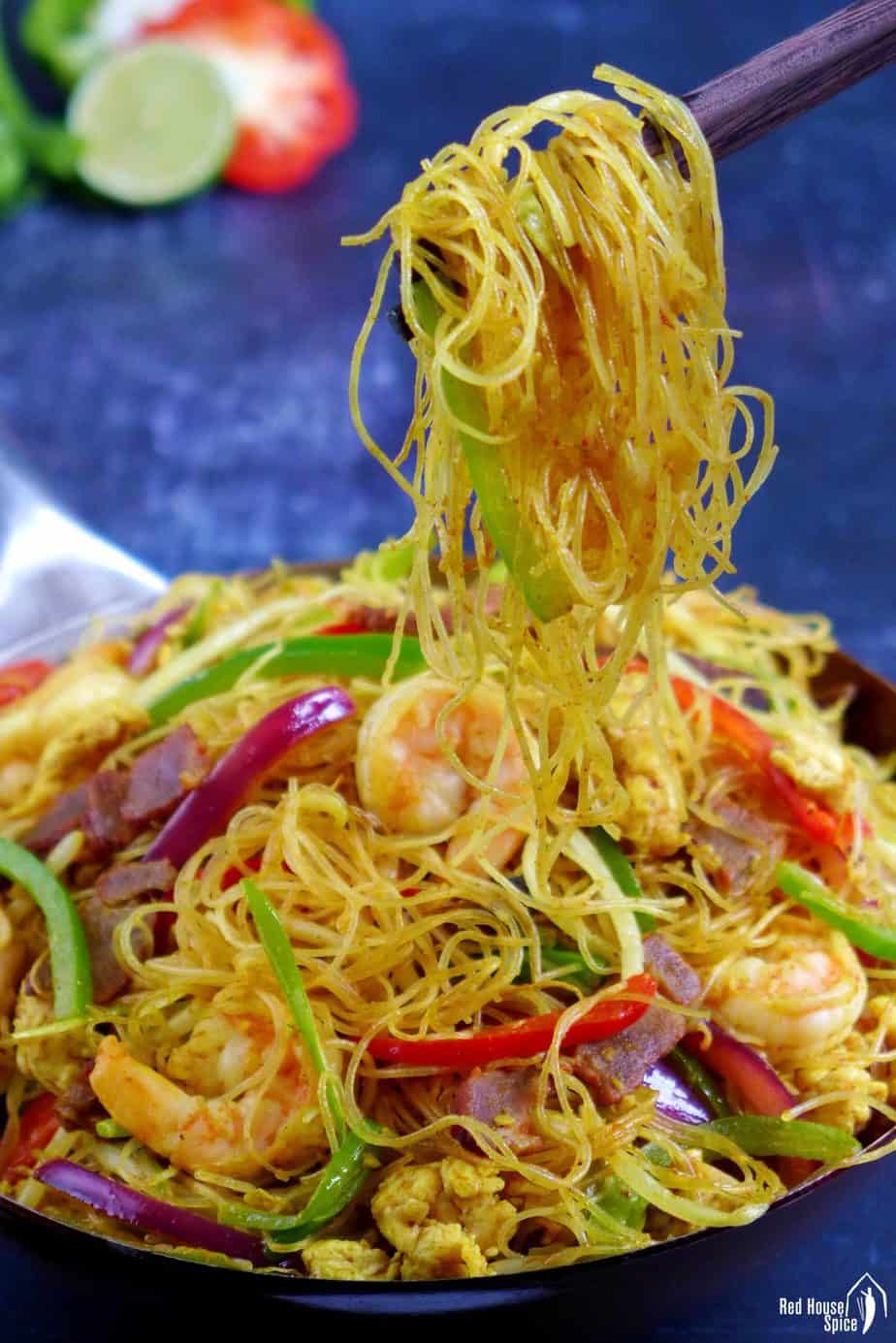
Jump to:
What is Singapore Mei Fun
I had been eating Singapore Mei Fun (Singapore Rice Noodles, 星洲米粉) for years before I realised it had no confirmed association with Singapore. Some believe it’s a creation by Hong Kong chefs based on Cantonese style fried noodles with influence from Southeast-asian cuisine. You can find it in Cantonese eateries and Hong Kong style tea restaurants (茶餐厅). Also, it’s a favourite on menus of Chinese takeaways (take-out) in the West.
As an advanced version of Chinese chow mei fun, Singapore Mei Fun consists of rice vermicelli seasoned with curry powder, soy sauce and stir-fried with egg, shrimp, Chinese BBQ pork & a variety of crunchy vegetables.
Combining many elements in one dish, it’s a hearty, appetizing meal bursting with flavours. My recipe is for making 2 adult portions but please feel free to double it up if you have a large wok to fry with.
Ingredients

As a tasty, complex all-in-one dish, Singapore Mei Fun calls for quite a few ingredients. But don’t be intimidated by the length of the list. The end result is so rewarding! I’m sure you will want to make it again and again. To give you a clear idea of the composition of the dish, I classify the ingredients into four groups:
- Noodles. More precisely, you will need dried rice vermicelli which is known as Mei Fun (or Mai Fun).
- Proteins. The traditional recipes use eggs, fresh shrimp and Char Siu (Chinese BBQ pork). I will write about substitute ideas in later sections.
- Vegetables. You would need a number of crunchy vegetables for adding another layer of texture. It would be even better if they provide different colours for an appetizing look.
- Seasonings. The must-have is yellow curry powder which gives the dish its iconic bright yellow colour. Other seasonings include soy sauce, oyster sauce, etc.
Cooking steps
Before I start explaining the tips on each cooking step, here is an outline of what to expect during the process.
- Prepare vermicelli until it’s softened but not yet fully cooked.
- Mix liquid seasonings and salt before you start cooking.
- Fry eggs and shrimp in oil then set aside.
- Release the aroma of curry powder and garlic in a little oil.
- Combine all the elements of the dish in a certain sequence to finish the dish.
Choose and prepare Mei Fun
The main star of today’s dish Mei Fun/米粉 (sometimes spelt Mai Fun) is a type of very thin, dried rice noodles also known as vermicelli or rice vermicelli. Be careful not to confuse Mei Fun with Fen Si/粉丝 which looks very similar but is made of mung bean starch and become much more transparent after cooking than Mei Fun (see examples in Spicy Vermicelli Stir-fry and Whiter Melon & Meatball Soup). When purchasing, check out the ingredient list if uncertain.
You might find Mei Fun of various brands made in different Asian countries. Generally speaking, you can use any of them for this dish. However, they might require different methods to prepare. Follow the instructions on the package to pre-cook/soak it before you start stir-frying.
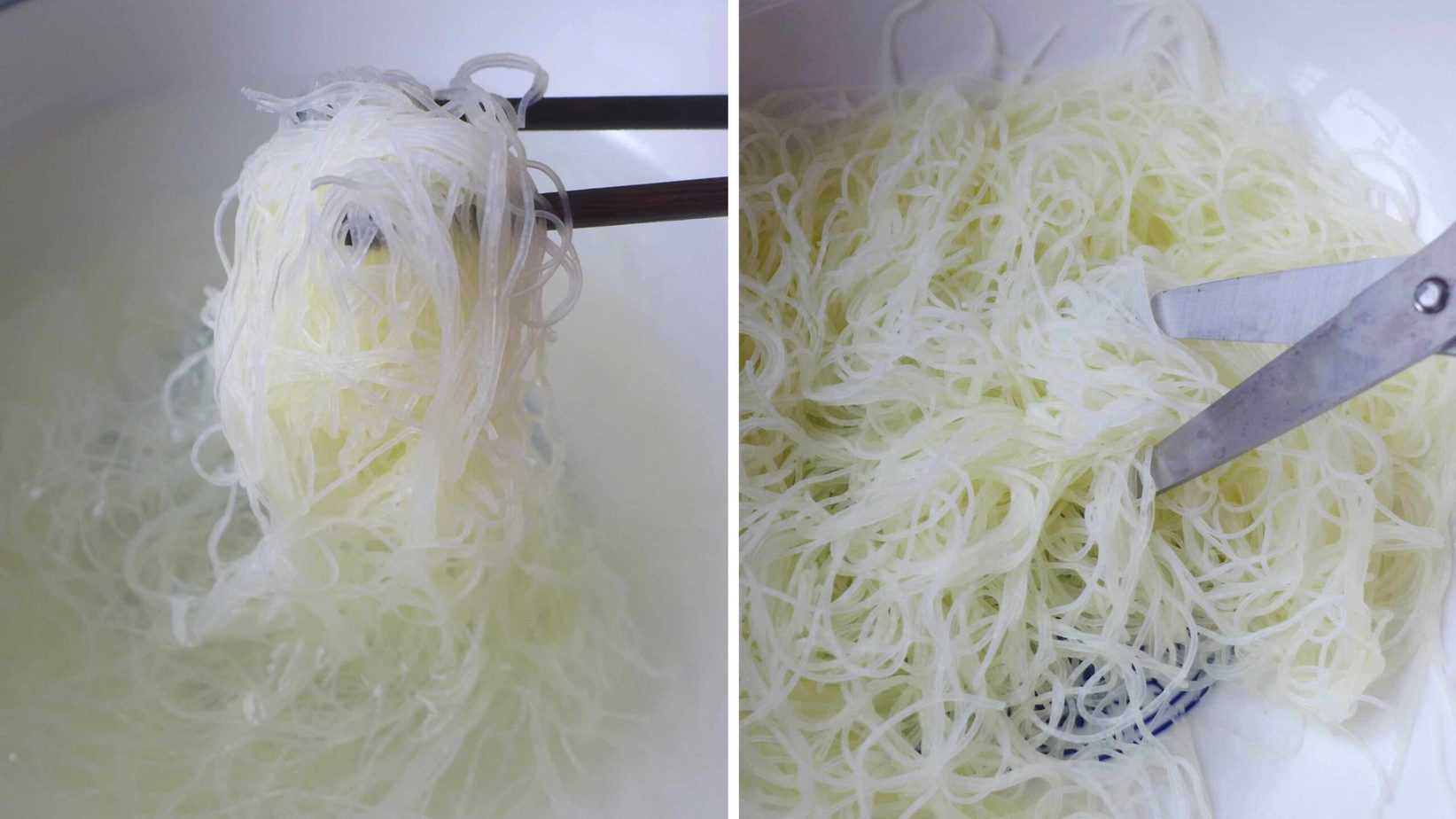
I often use a Taiwanese brand of Mei Fun which advises boiling the noodles for 1 min. For me, a better alternative is to soak them in very hot water for 2 mins (because I find it less hassle to boil water in a kettle than to cook the noodles in a pot). At this stage, your Mei Fun should be pliable and springy, but not fully cooked. Otherwise, they will become mushy during the next step, stir-frying.
No matter how you prepare them, remember to cut the pre-cooked/soaked noodles into shorter sections with scissors. This will make stir-frying and serving a little easier.
Proteins & substitutes
Usually, you would find one single protein ingredient in Chinese-style noodle dishes. Singapore Mei Fun, however, typically requires three! The most common choices are egg, shrimp and Char Siu (Chinese BBQ pork). It’s kind of luxury for a simple noodle dish. I think this is one of the reasons why it’s so popular!
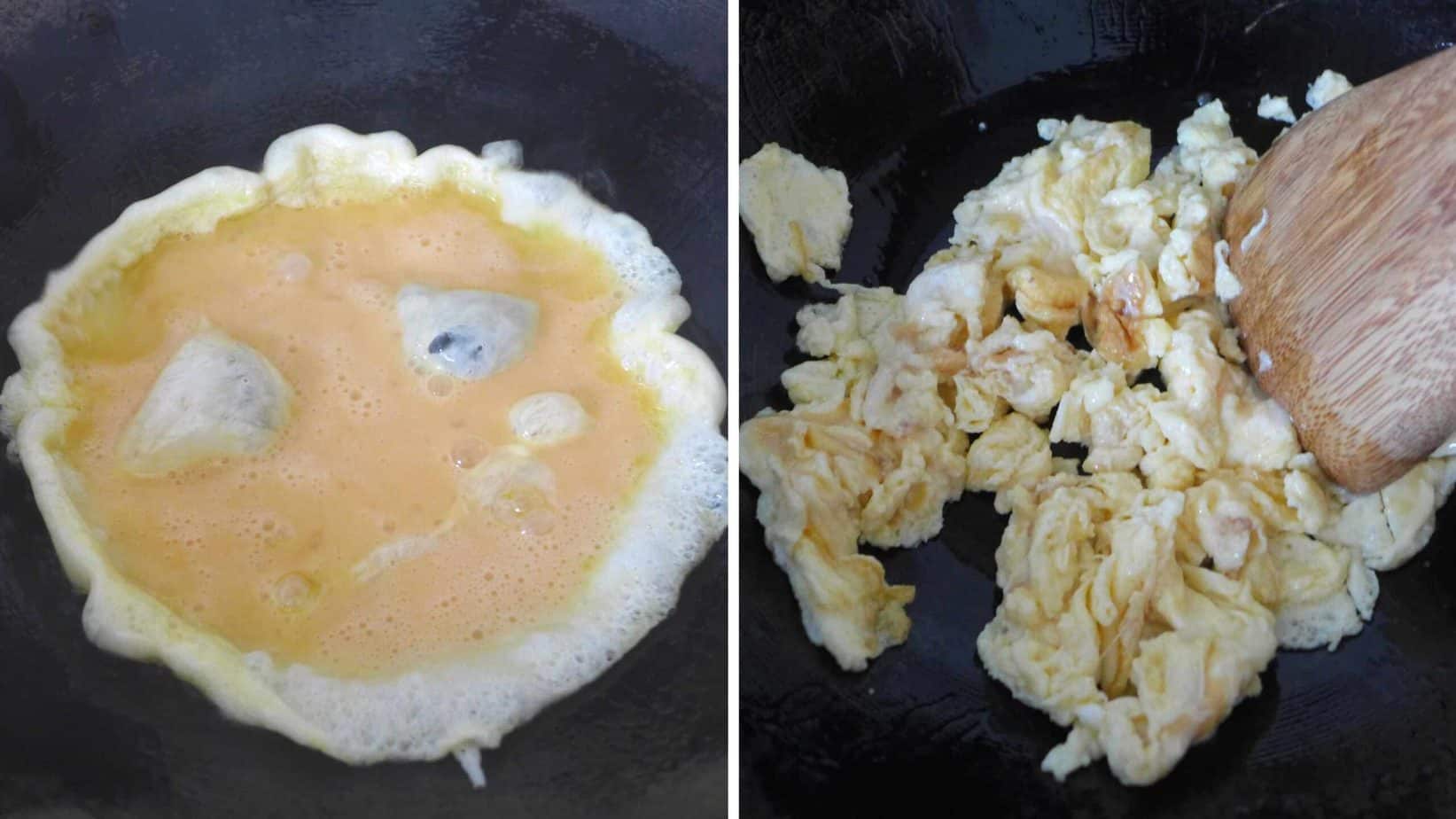
Egg. This is the first thing you need to cook. Use the same method I introduced in Tomato & Egg Stir-fry and Egg Fried Rice Noodles. Heat up the oil over high heat until it smokes. Pour in the lightly beaten egg. When it turns solid, break into small pieces with a spatula. Dish out and set aside.
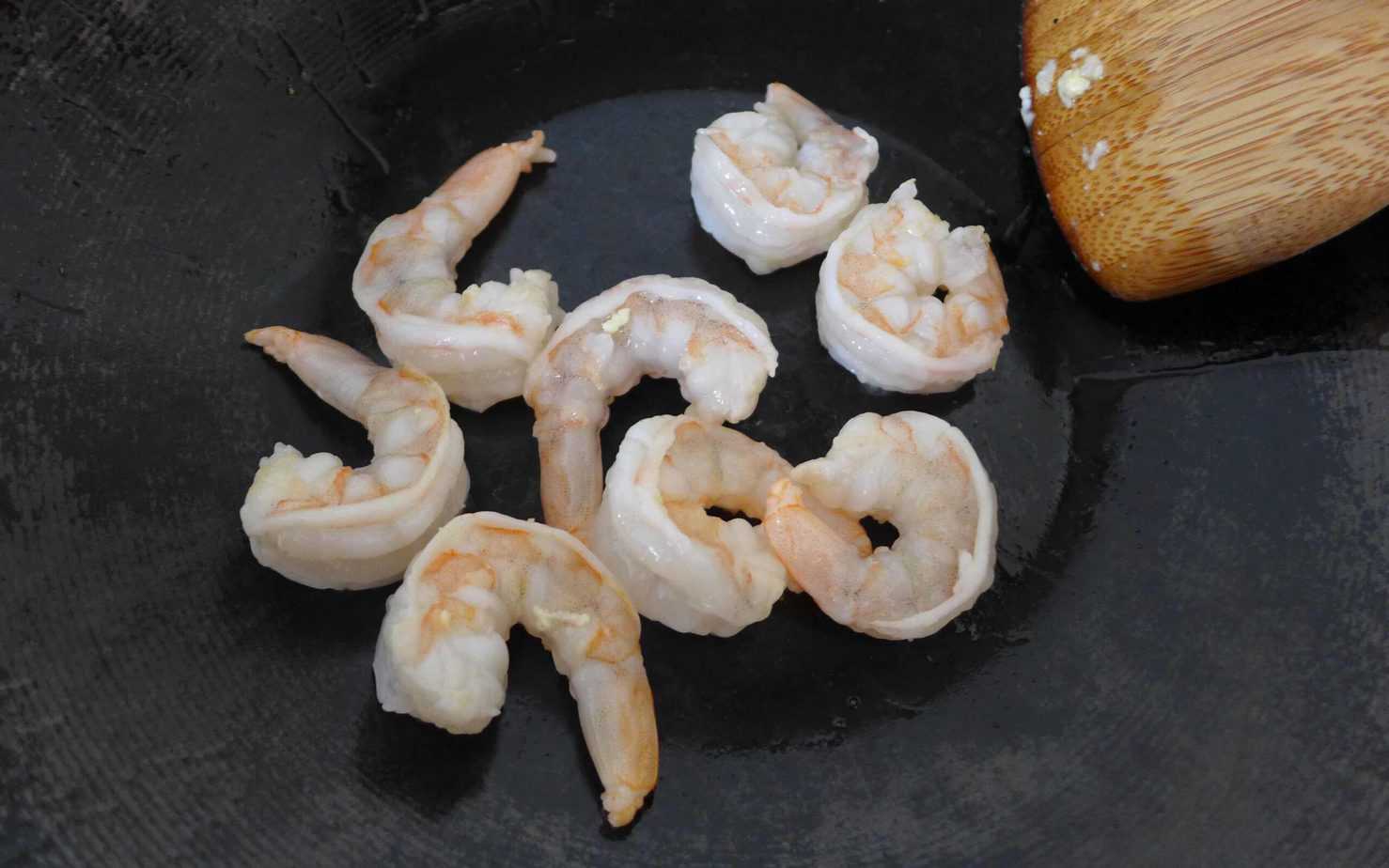
Shrimp. After you scoop out the egg, use the same wok (there should be a thin layer of oil left) to briefly seal the shrimp. Once they turn pink and curl up, transfer out straightaway. To retain their tenderness, do not overcook .
Char Siu. Since it’s already cooked, add Char Siu later along with vegetables. Have you ever tried making Char Siu yourself? If not, check out my post on Easy Char Siu which shows you how to cook it to a perfect texture with ease.
🛎 CAN I USE SUBSTITUES? Yes, you surely can! Replace one or two of the above ingredients with shredded chicken, sliced Chinese sausage, beef strips (learn how to prepare it in my recipe for Beef Chow Fun), etc.
🛎 CAN I SKIP EGG AND/OR MEAT? You can do that too. To make this dish vegetarian/vegan friendly, I suggest you use five-spice tofu or smoked tofu as protein. It will taste very nice too!
Use yellow curry powder
Another feature that makes Singapore Mei Fun stand out is its bright yellow colour. This appetizing look comes from yellow curry powder which contains turmeric (a spice known as poor man’s saffron). Please feel free to use any type of yellow-coloured curry powder that’s available to you. Alternatively, use brown-looking curry powder and add extra turmeric for the colour.
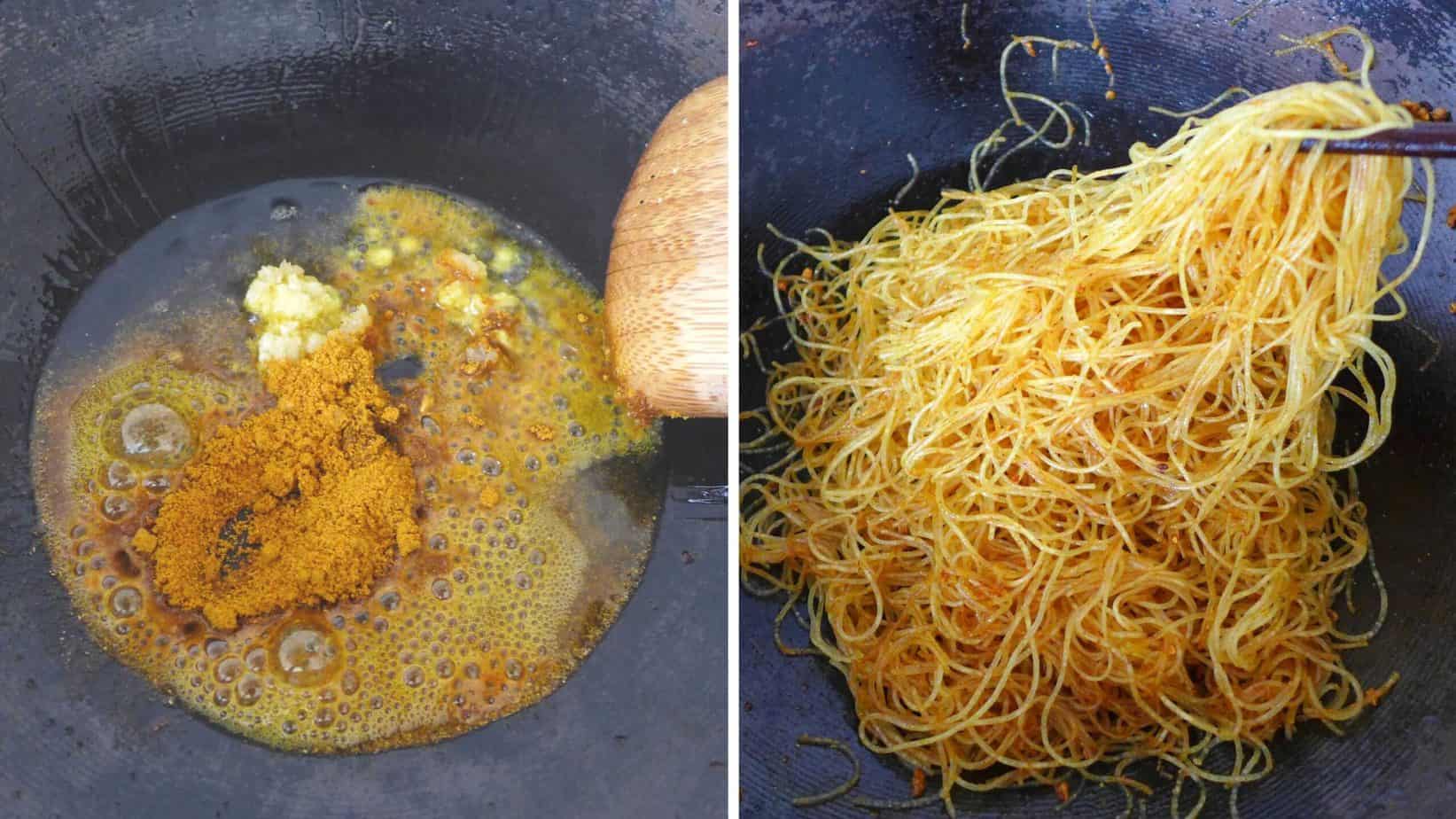
After you’ve cooked the egg and shrimp, add more cooking oil to the wok. Fry curry powder and some minced garlic over low heat to slowly release their aroma. Pay attention not to burn them though. When you see bubbles becoming intense, it’s time to add Mei Fun.
To efficiently coat the Mei Fun with the curry, I recommend you keep the heat low and use a pair of chopsticks to stir, flip and loosen the noodles. Once they turn yellow evenly, turn the heat up to medium high and move on to the next step.
Add crunchy vegetables
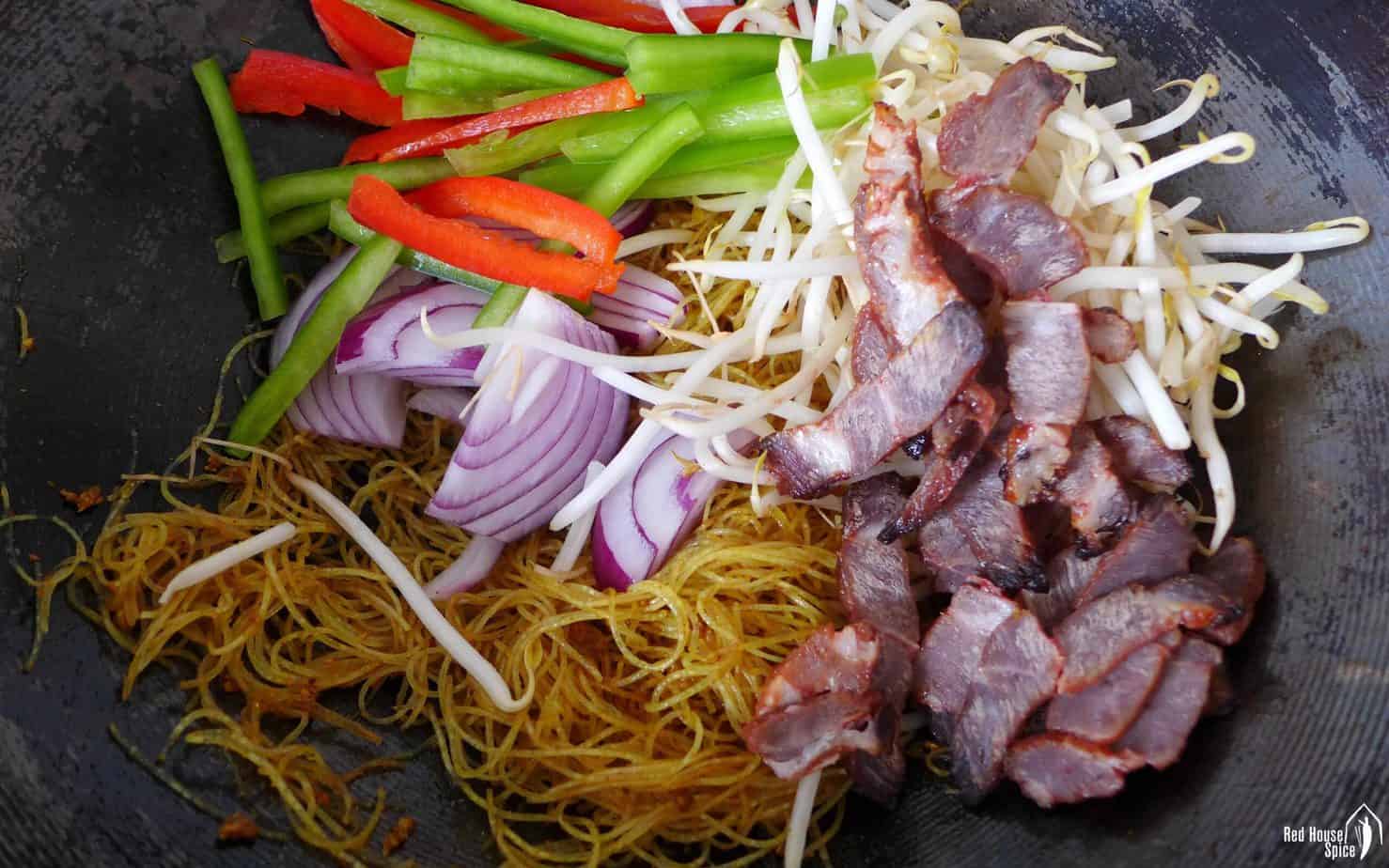
I choose three crunchy vegetables, mung bean sprouts, red onion and bell pepper, to go into this noodle dish. They also provide wonderful colours to make it even more appealing on the eyes. Add them to the wok along with Char Siu. Use chopsticks and spatular together to stir constantly. Once they’re evenly heated, you can put in the egg and shrimp.
If you happen to have other vegetables at hand, don’t hesitate to substitute. carrot, napa cabbage, courgette, Chinese chive, stem lettuce, etc. Just mix and match whatever you fancy!
About the sauce
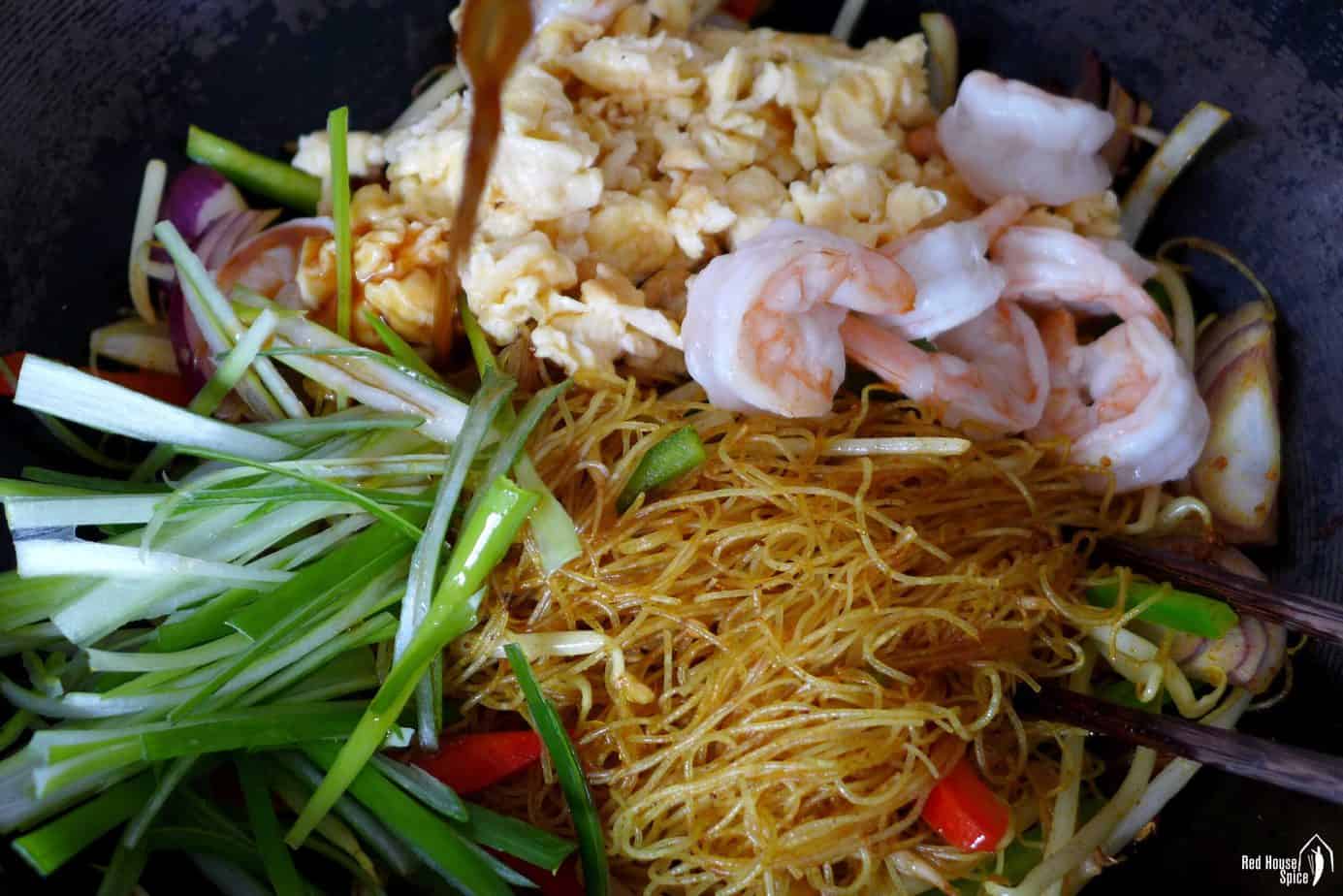
Now, it’s time to pour in the sauce and sprinkle some finely chopped scallions to finish. As I always emphasise when writing recipes for fast stir-fry dishes, remember to have the sauce mixed before you begin to cook. You’ll need soy sauce, oyster sauce, Shaoxing rice wine (optional), sesame oil, lime juice, salt and a little sugar. Give everything a quick final stir then dish out to serve.
Other noodle recipes
Looking for more inspiration on all-in-one noodle dishes? Have a look at these recipes:
- Hearty and flavourful, Zha Jiang Noodles is a signature dish of Beijing cuisine.
- One of the most loved noodle dishes in China, Lanzhou Beef Noodle Soup is worth every effort to make.
- Try my recipe for Big Plate Chicken with Belt Noodles if you’re looking for a crowd-pleaser.
- Popular street food of Sichuan cuisine, Dan Dan Noodles is very easy to make yet packed with exciting flavours.
- Sichuan Style Cold Noodles is a great choice if you fancy something refreshing with a pungent taste.
- Symbolizing long life and prosperity, Longevity Noodles are a must-have dish for many special occasions.
📋 Recipes
Love this recipe? Please leave a 5-star 🌟🌟🌟🌟🌟 rating in the recipe card below & if you REALLY like it, consider leaving a comment as well!
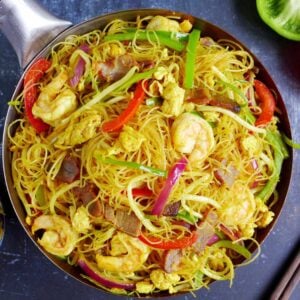
Singapore Mei Fun (Singapore Rice Noodles, 星洲米粉)
Ingredients
Noodles
- 90 g dried rice vermicelli (Mei Fun) - see note 1
Seasonings
- ½ tablespoon light soy sauce
- ½ tablespoon oyster sauce
- ½ tablespoon Shaoxing rice wine - optional
- ½ teaspoon sesame oil
- ¼ teaspoon salt - or to taste
- ½ teaspoon sugar
- ½ lime, use the juice only
- 1 tablespoon water
Oil
- 2 tablespoon neutral cooking oil, divided
Proteins
- 2 eggs, lightly beaten
- 8 shrimps, peeled and deveined
- 50 g Char Siu (Chinese BBQ pork) - see note 2 for substitutes
Aromatics
- 2 cloves garlic, minced
- 1 tablespoon yellow curry powder - see note 3
Vegetables
- 100 g mung bean sprouts
- 60 g bell pepper, julienned
- 60 g red onion, sliced
- 1 stalk scallions, julienned
Instructions
Prepare the vermicelli
- You can either follow the instructions on the package to prepare the rice vermicelli or use my method: Put them into a large bowl. Pour in hot water (just boiled) enough to cover. Leave to soak for 2 mins.
- Drain well then cut into shorter sections with a pair of scissors. Set aside (see note 1).
Mix the sauce
- In a small bowl, mix light soy sauce, oyster sauce, Shaoxing rice wine, seame oil, salt, sugar, lime juice and water. Set aside.
Fry the eggs & shrimp
- Heat up half of the cooking oil in a wok until it smokes. Pour in the egg. Fry until cooked then break it into small pieces with a spatula. Transfer to a plate.
- In the same wok, sear the shrimp (no need to pour in more oil). As soon as they curl up and turn pink, transfer to the egg plate.
Stir-fry to finish
- Pour the other half of the cooking oil into the wok. Fry garlic and yellow curry powder over low heat for 20 seconds or so (Do not burn).
- Stir in the vermicelli. With the aid of a pair of chopsticks, loosen the vermicelli to have it evenly coated by the curry.
- Turn the heat to medium high. Add Char Siu, mung bean sprouts, bell pepper & red onion. Constantly stir (I use chopsticks and a spatula at the same time) to evenly heat all the ingredients until the vegetables are cooked but still retain some of the crunchiness.
- Put the egg and shrimp back into the wok. Add the sauce and scallions. Give everything a quick stir then serve immediately.
NOTES
NUTRITION
NUTRITION DISCLOSURE: Nutritional information on this website is provided as a courtesy to readers. It should be considered estimates. Please use your own brand nutritional values or your preferred nutrition calculator to double check against our estimates.


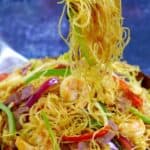
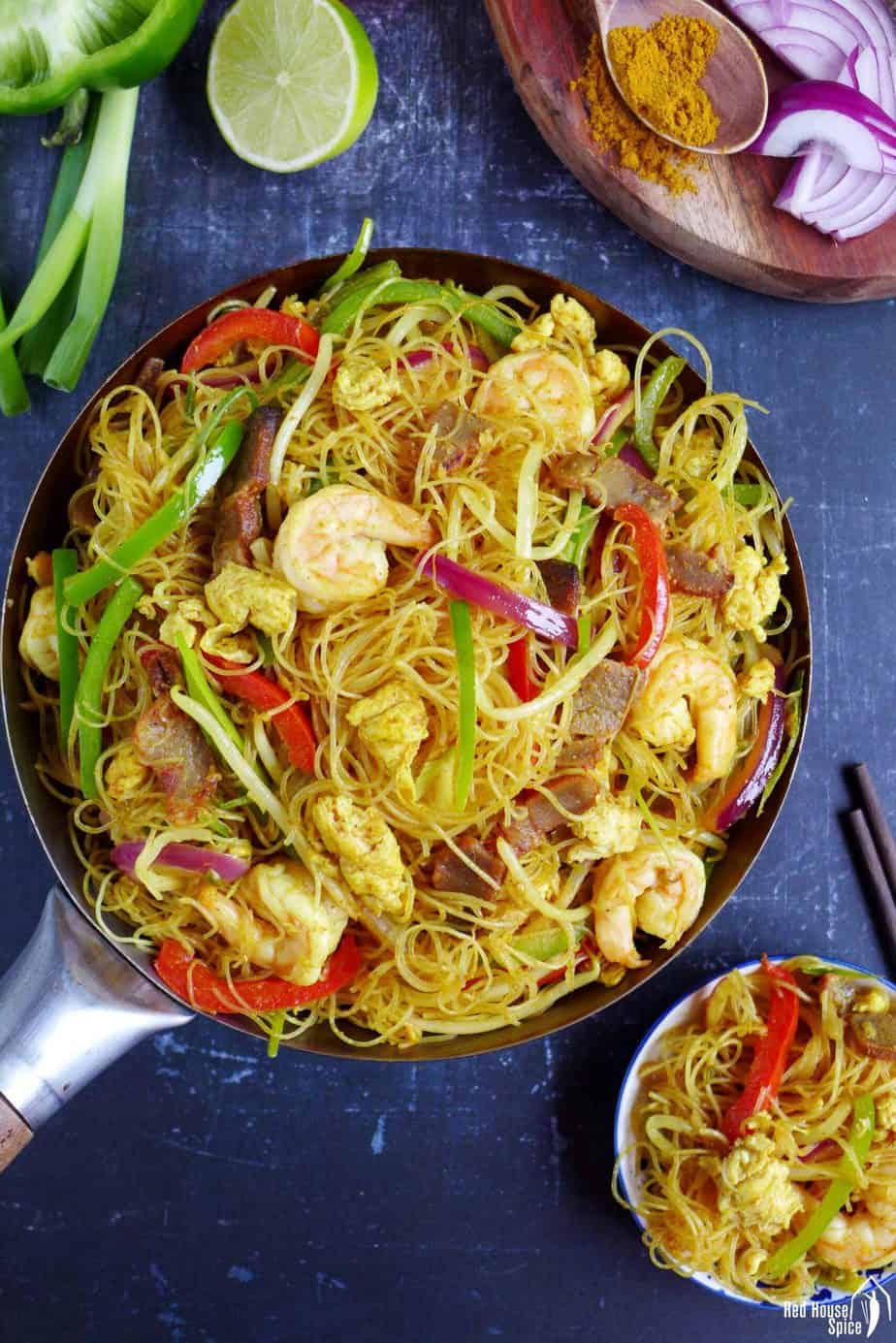
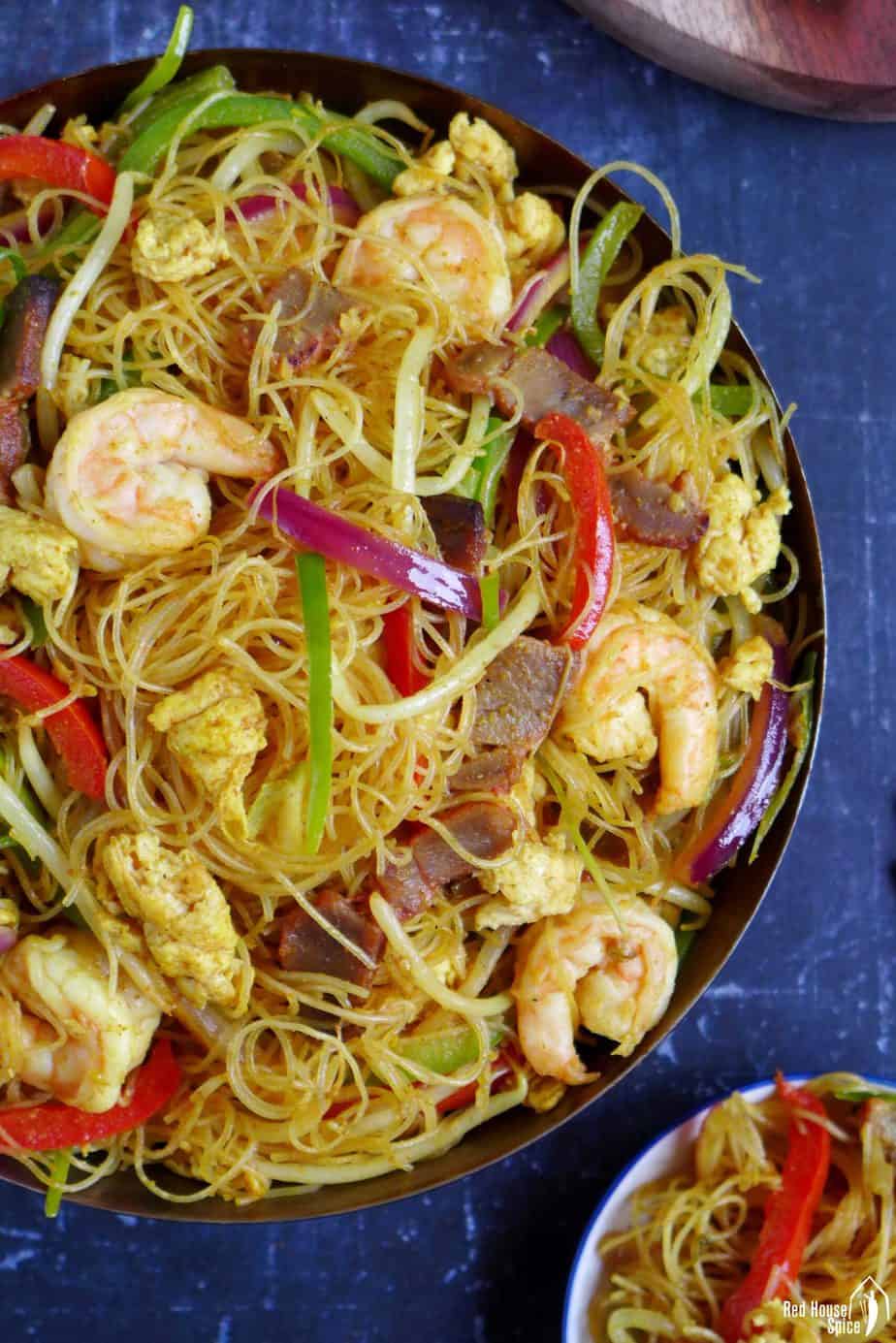
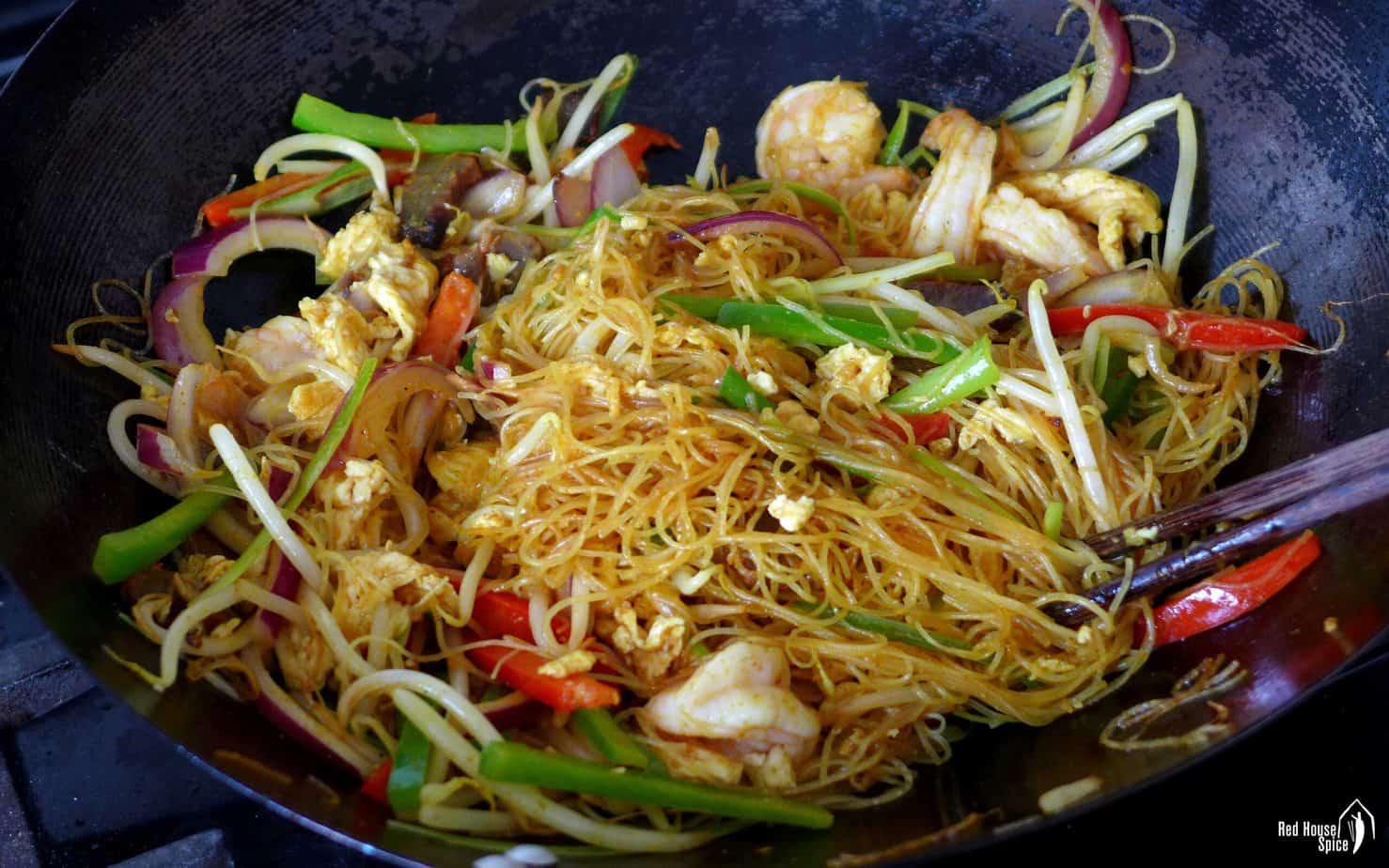
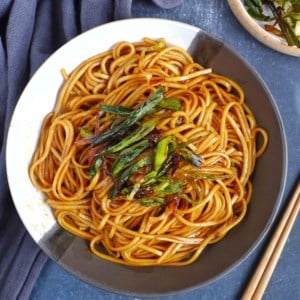
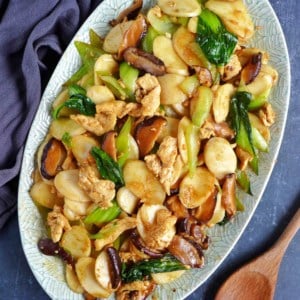
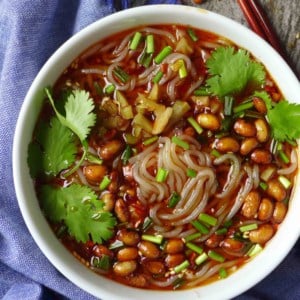
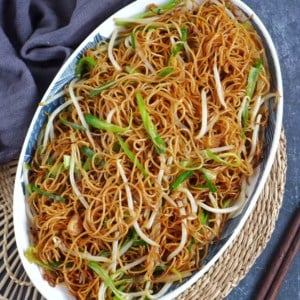
I believe that adding a bit of curry powder and or turmeric to the soaking water adds a bit more color and flavor to the noodles.
I haven’t tried that way but it sounds like a good idea.
I came across your recipe while looking for a new dish to use the mung beans I had just sprouted. The dish turned out excellent. While prepping I realized I was out of shrimp in the freezer so I fried up some Chinese sausage instead. It turned out perfect. Thank you for the wonderful recipe. I have already printed it & added it to my recipe index. I am looking forward to trying some of your other dishes.
Delighted to hear that Roger! Have a fun time cooking more tasty dishes!
Amazing! Added sauteed chicken to make it a 4 protein meal! Incredible!
Thank you for the recipe Wei! I used your method in cooking the noodles and it was perfect.
You’re welcome Jennifer!
Outstanding! Thank you, also, for fixing my mei fun noodles! So simple. Your recipe has such a delicate balance of flavors. Instant hit here! I’d probably double up on the curry but that’s living in Texas.
Now I’m moving on to your Hot and Sour Soup.
Thank you ma’am!
So happy to know you’ve enjoyed it! Hope you’ll like my recipe for Hot and Sour Soup too.
probably one of my all time favorites . great recipe ..I’m never going to get out of the kitchen …thanks
So happy to know you’ve enjoyed it!
made char sui for singapore noodlesEXACTY
not bad but not quite how I remember them Singapore
ah also I thought I had scrimp in freezer but did not so I used Scallops instead.
Modified recipe some as I was using up some food items & missing others. Modified as follows: subbed scallops & straw mushrooms for char siu pork. Subbed green cabbage for Napa cabbage. Increased minced garlic. Subbed mung bean threads for noodles. Used sesame oil & chili oil to cook with. Taste:#9.5/10. Spiciness: #2/10. NOTE:. Lots of prep & dishes generated.
Your dish with substitutes sounds delicious too!
We used to have this dish every time we went to Penang to have our Thai visa renewed. I did not know what it was called and could not find a recipe that looked even remotely similar. Thank you SO much for posting this recipe! Everyone in the family will be so excited when I cook this. They will also be happy because I will FINALLY make char siu again…
You’re welcome Alejandra! Happy cooking!
What a find! Your website is terrific. I’ve already made the dumpling wrapper recipe and I will never buy the store-bought ones again! And the Singapore noodles are just like I remember them from Hong Kong. I plan to cook my way through many of these recipes, for sure.
Oh, and thanks for warning readers not to substitute balsamic vinegar for Chekiang vinegar–I have seen too many recipes suggesting that substitution, and the flavor is completely different.
My pleasure Janet! So happy to know you find my posts/recipes valuable. Enjoying your time in the kitchen!